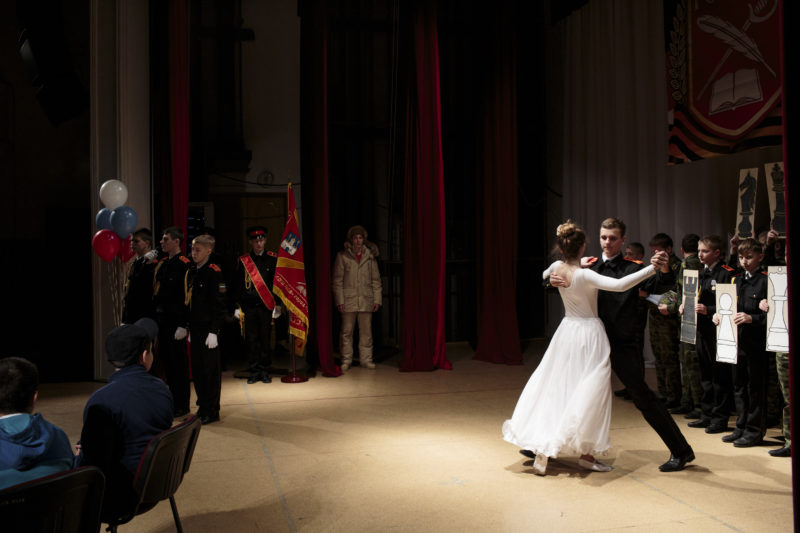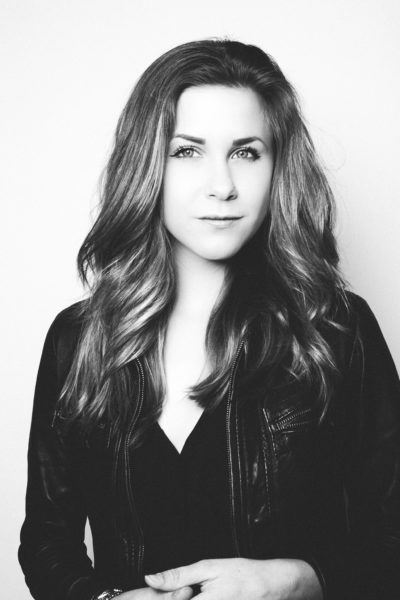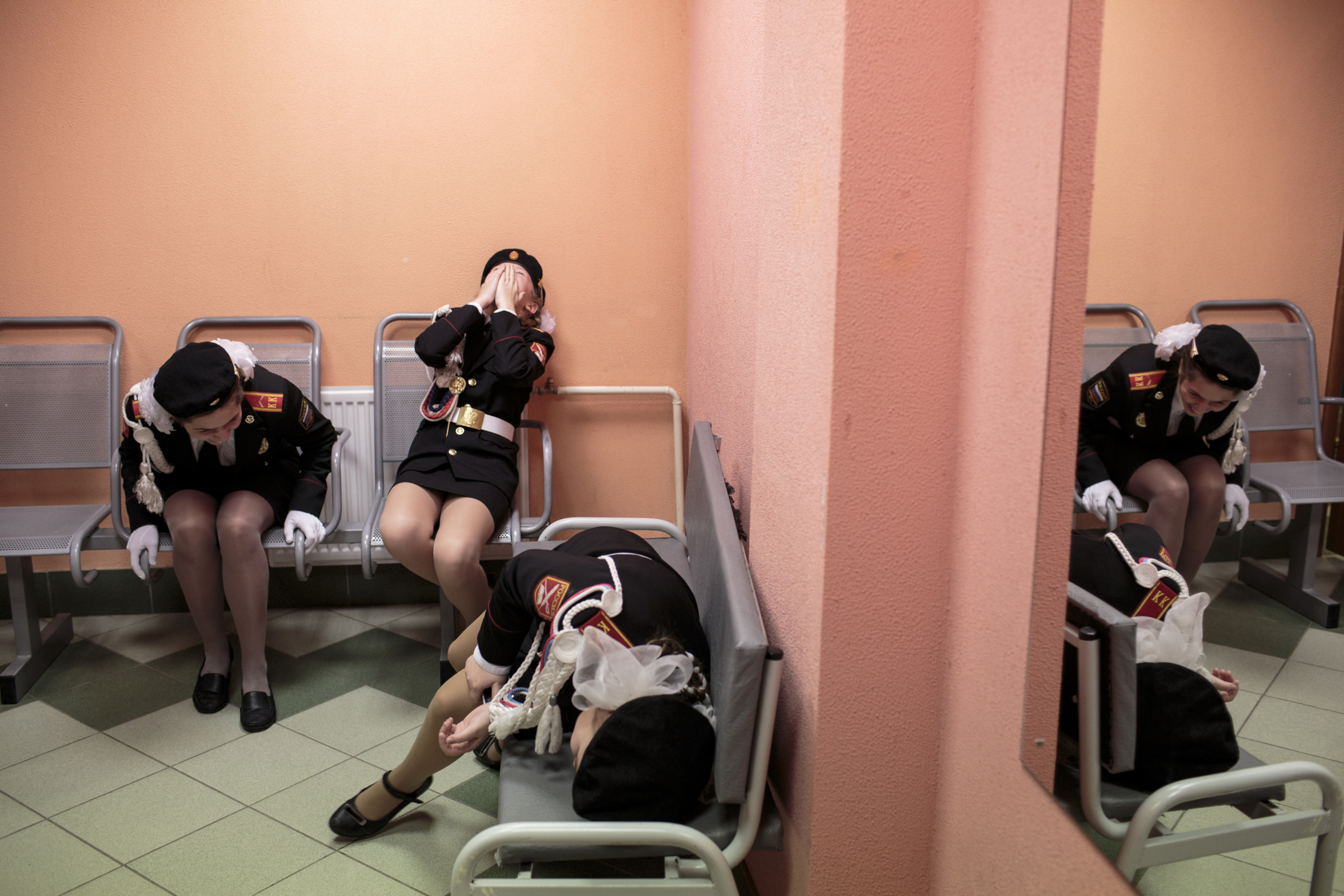Sign up for The Media Today, CJR’s daily newsletter.
IN JULY 2016, A FLAXEN-HAIRED BOY lay in a field of clover, sighting down the barrel of a handgun near the town of Borodino, Russia. He was one of a dozen teenagers, boys and girls, attending a youth patriotic camp built by the Russian government as part of an effort to increase military recruitment numbers. It was not the kind of place one would expect to find an American documentary photographer.
“I had to call maybe 50 camps before one of them let me in,” says Sarah Blesener, a New York-based photographer who is nearly fluent in Russian. “At a lot of these places, sometimes I was the first photographer allowed to come, and usually the first American at all.”
Last spring and summer, Blesener traveled the Russian countryside making photographs that document the rise of patriotism among Russian youth. Photographs from the resulting series, “Toy Soldiers,” were widely published, and established Blesener as a rising talent in documentary photography.
Now, backed by two of photography’s most lucrative fellowships, Blesener is once more photographing youth patriotism. This time, however, she has focused her efforts on the United States.
If I only profiled people who had Swastikas, it would make everything seem so extreme… Extremism is not a good way to narrate this story.
Blesener’s recent success is “like winning the lottery twice,” says Glenn Ruga, director of the Social Documentary Network, which published “Toy Soldiers” in its magazine ZEKE. “Sarah has struck a chord with photo editors for the timeliness of the issue and just how rock solid her work is.”
In the wake of last year’s election, it’s become something of a trope for coastal journalists to descend on flyover country in an attempt to, as Rachel Schallom wrote in a blog for NiemanLab, “stop thinking of these people as subjects we cover and relate to them as neighbors, friends, and readers…” Ruga suggests that Blesener—a young American photographer just back from documenting the forces of nationalism unleashed by President Vladimir Putin—is uniquely suited to set off across the United States and explore the same forces taking hold in communities that helped to elect President Donald Trump.
For her part, Blesener strives to resist pigeonholing herself, the project or her subjects.
“If I only profiled people who had Swastikas, it would make everything seem so extreme,” Blesener says. “It would miss the point of what’s happening in this cultural movement that’s so much more in the middle. Extremism is not a good way to narrate this story.”

A photograph from the “Toy Soldiers” series, courtesy of Sarah Blesener.
DURING A RECENT VISIT TO AN ROTC CAMP in Kentucky, the camp director asked Blesener point-blank, “You’re not going to call us the ‘alt right,’ are you?”
There is a popular awareness, says Blesener, of the media’s tendency to objectify Republican voters who own guns and aspire to join the military. She told the camp director not to worry. “Afterwards, I thought about how messed up it is that’s actually a fear people have. These groups have been around for so long, but all of a sudden we’ve coined a magical phrase to describe them.”
To avoid such objectification, Blesener is highly selective in the images she presents to editors— a lesson she learned while putting together “Toy Soldiers” in Russia.
“After a few months, I thought to myself, ‘I can’t keep photographing kids with guns. It’s only going to freak the public out.’ I had to take a poetic approach and find the nuanced moments that I thought spoke more to identity and youth; aspects that are more important than guns and guns and guns.” She adds: “Our aim as photographers should be to fight fear. Fear doesn’t produce anything but more fear and propaganda.”
To get beyond the guns, Blesener has a unique methodology for gaining access in a community: couch surfing.
“It opens up conversations with people who are different and similar to me,” Blesener says. “People give me the keys to their city. It also makes it so I can’t just disconnect and drive home or go to a hotel. When you’re immersed and can’t leave, you’re committed to a different level.”
So far, Blesener has traveled to Pennsylvania, Virginia, New York and Kentucky. She finds her subjects with the help of organizations like the National Rifle Association, the American Legion and high school ROTC programs.
“These groups are old American traditions,” she says. “They don’t get a lot of media inquiries, so they’re easy to contact and they’re excited to have a photographer come visit.”

Sarah Blesener, courtesy of the photographer.
BLESENER’S PROJECT IS PART OF A growing trend towards long-term documentary photography projects that prize visuals over writing. “Through innovative, full screen photo-centric web designs and effective digital dissemination,” wrote Phil Bicker, then a Senior Photo Editor at Time, “these photo essays are drawing our attention—in different and often more meaningful ways—to important issues that we otherwise would ignore or at best feel we had seen too many times before.”
Another good example is Daniel Berehulak’s photo essay “They Are Slaughtering Us Like Animals,” about Philippine President Roberto Duterte’s antidrug war, which won a Pulitzer Prize and a World Press Photo award. Berehulak, a well-established photographer, shot the project over 37 days—a long-term assignment, by newspaper standards. The investment of time yielded a depth of photojournalist reporting that verges on documentary art.
“I think photographs that only convey information don’t have a lot of value,” says Mike Davis, Alexia Tsairis Chair of Documentary Photojournalism at Syracuse University, a role supported by the Alexia Foundation. “In a ‘words versus pictures’ realm—sadly, that’s where things have been, and I think it’s starting to be a different environment now—words are the starting point and pictures have to follow. That cripples a photographer the same way it would a writer if you told them which verbs they had to use.”
With more and more newsrooms closing their photography departments, local newspapers are putting even less priority on visual reporting. The rise of photography fellowships like Alexia and Catchlight are a response to that. Guy Martin, a British photographer based in Turkey, told the BBC, “Grants, awards and scholarships are a lifeline for me. Without them, no work would be possible. They add to what you can do and how ambitious you want to be with your personal work.”
The formula works like this: a fellowship provides funding for a photographer to complete a personal project like “Toy Soldiers,” which the photographer is encouraged to publish widely, often in publications that couldn’t fund such an in-depth project. When Sebastián Liste, winner of the 2014 Alexia Foundation Professional Grant, submitted a report showing everywhere photos from his project had been published, the document totaled 30 pages.
Blesener acquired $50,000 in support for her project, from two fellowships: the Alexia Foundation Professional Grant ($20,000) and the Catchlight Fellowship ($30,000). She will have similar latitude to publish, though Catchlight requires her to publish a final project with Reveal, a website run by The Center for Investigative Reporting and a partner of the fellowship.
“Investigative work can be tough to portray in images because a lot of it is based on documents and data,” says Amy Pyle, Reveal’s Editor in Chief. “So it’ll be interesting to see how it works going the other direction, when we know there are visuals, and see what the story is behind them.”
That’s not to say Blesener doesn’t appreciate good writing.
“I get way more inspiration from literature than I do from photographers,” Blesener says. “It helps me to start seeing things in a narrative sense. In Russia, I was influenced by The Brothers Karamazov by Fyodor Dostoyevsky. The way he formed the narrative and profiled the characters, it got me to see things in different light. Now I’m reading a lot of Steinbeck, The Grapes of Wrath and East of Eden. These books relate to what’s happening in our time. If I can create a photo essay that profound, I will be happy.”
Has America ever needed a media defender more than now? Help us by joining CJR today.



